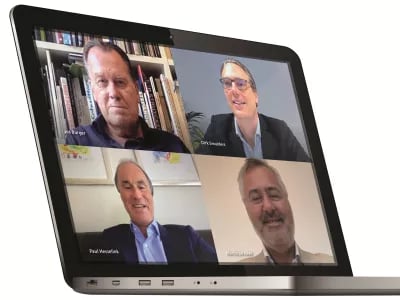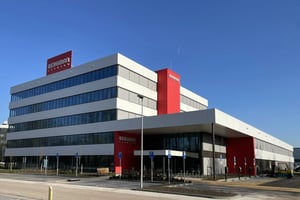Earlier this year, the COVID-19 outbreak in China and the pandemic that followed looked set to completely disrupt the global economy virtually overnight. Countries hastened to close their borders, supply chains were hit hard, and entire markets were temporarily shut down. Four CEOs of NPM Capital portfolio companies – Ultimaker’s Jos Burger, Kiwa’s Paul Hesselink, Dirk Smulders of Dieseko, and Mentaal Beter’s Martin de Heer – joined our digital roundtable discussion to share how their organisations have responded to these extraordinary circumstances.
The outbreak
Hesselink: ‘Why don’t I kick off? Since Kiwa operates a site in Wuhan, we had skin in the game at an early stage. In fact, we had just received official approval from the Chinese government for an acquisition we completed in late 2019, when the area went into full lockdown. So we suddenly found ourselves with 650 employees working from home. It would be an understatement to say we were caught off guard by the situation, but fortunately we showed ourselves to be pretty resilient in the circumstances. I think what helped us is that we’re a company with a very decentralised organisational structure, and our local management is very adept at making the right decisions on the spot very quickly. When the Chinese government began imposing travel restrictions, our people soon switched to remote auditing through digital channels. It meant we were able to protect a good chunk of our revenue.’
Burger: ‘We also became aware early on that something was amiss, because we have an office in Singapore, where our Chinese colleagues gave us daily updates on the latest developments – and those reports were pretty grim. This was back in January, and I remember hoping against hope that the problem would be contained and would remain local. But even if that had been the case, we still wouldn’t have been able to ignore it: we have around 40 suppliers who operate out of China, either directly or indirectly, or who have Chinese subcontractors. So there’s a high level of dependence on Chinese suppliers across the entire supply chain.’
Smulders: ‘Same here. When the virus first emerged in China, we caught on right away that things could get pretty bad pretty quickly. We have an office in China that operates a fleet of rental vehicles delivering load testing solutions throughout the country. Then, overnight, all the provincial borders were closed, everyone had to be quarantined, and people were literally locked away on building sites. This led to our entire business being temporarily shut down. Fortunately, the Managing Director of our Chinese site happened to be visiting us in the Netherlands just at that time. We began working with him immediately to collect best practices and share these with other companies in order to be able to make smart decisions quickly. We looked, for example, at what needed to be done to protect our colleagues, ensure the continuity of our projects and manage our fleet of rental vehicles. Since we were able to act so fast, we managed to limit our Chinese losses somewhat in the end.’
De Heer: ‘The pandemic only started to affect us after the Dutch government announced their ‘intelligent’ lockdown. Our company suddenly found itself with the challenge of setting up remote working practices online and facilitating mental health care treatments through telehealth. Luckily, we had some prior experience – we were already doing this on a modest scale – but to suddenly try to get 1,000 practitioners to log on to a system designed for dozens of users was challenging to say the least. Our IT department was under huge pressure to get everything set up those first two weeks, and we were busy 24/7 to make it happen.’
The supply chain
Burger: ‘Like I said, our dependence on Chinese suppliers was what initially made us want to focus completely on our vendors. So we went and checked whether we could move some deliveries forward and if we might be able to purchase parts and components elsewhere, at a higher price if necessary. In other words, we did everything we needed to do to keep producing and supplying. I’m pleased to say it went well, as we also had a strategic ‘wartime’ stock of parts and finished products. That gave us the relief we needed to figure out where to take things from there. I have no qualms in saying that we have the problem under control now: even if the supply chain ends up breaking down, we’ll have enough to keep us going for months.’
Smulders: ‘Our experience has actually been very similar to yours. At our Dutch site, we build machines for which we source parts and components from all over the world. Our supply chain is quite well organised, with optimised safety stocks, so if your people in China and Italy suddenly stop supplying parts, you know you’ve got a serious problem on your hands. This involved dozens of vital components for which we had to reallocate the sourcing in Europe or elsewhere. Since the Dieseko supply chain team was able to work their magic, we managed to deliver everything on time. But I admit that it took a lot of blood, sweat and tears.’
Hesselink: ‘Sourcing was fortunately never really an issue for us, as we’re a service provider. We were especially lucky in that our entire company switched to a new IT backbone last year, so by Christmas most workstations had migrated to the cloud. This means we were suddenly able to get a lot more work done in 2020 in terms of remote auditing, which requires a lot of bandwidth and the exchange of vast amounts of data. So when the coronavirus epidemic started hitting Italy, we were able to quickly switch to digital inspection and auditing over there. We were then able to replicate this in the Netherlands, Spain and other European countries.’
De Heer: ‘Our ‘supply chain’, as it were, is a combination of Philips’ Engage client platform and video calls with KPN’s Zorgmessenger (Care Messenger) system. Many hospitals and outpatient healthcare providers switched to the latter system at the same time – only it turned out to be unequipped to handle the sudden surge in data traffic. That’s why we quickly started diversifying to multiple platforms, and also, to an extent, to solutions using our own server, which is GDPR-compliant. We had to wing it a little, but it all worked out in the end.’
What happened next?
Burger: ‘Once we had eliminated those initial threats, the next question was: how will this affect the industries in which our clients operate, including the automotive and aviation industries? Well, we came up with every possible scenario, and with each of these scenarios we looked at each other and said: ‘We really have no idea.’ It was like being blindfolded and then led into a darkened room, with no clue where things were headed. We now have a better grasp of what’s going on, and we’re finding that our business actually appears to be benefiting from the crisis. The systems we build don’t cost half a million euros; they’re smaller 3D printers, reasonably priced, with excellent value for money and very mobile, which means you can use them both at work and at home. They can also be used for coronavirus-related purposes, such as printing face masks and ventilator components. Of course, it’s anyone’s guess how all this is going to pan out – things will remain highly uncertain for the foreseeable future. We serve a highly complex, global network of sales partners, resellers and distributors, and want to avoid all sorts of unnecessary financial risks due to overstocking or underestimating or overestimating market demand.’
Smulders: ‘I know what you’re saying. Our customers are also spread all over the world, and we’ve seen different responses in each country. Some countries’ governments are looking to invest more money in infrastructure in an attempt to support businesses, but there are also countries that are slipping into a recession and are dragging their construction industries along with them. For the time being, most construction projects are proceeding on schedule and our clients have enough orders to keep them going for a while. That’s why our rental and spare-part business has been ticking over as well, particularly as more borders will start to reopen. We’re in a trickier spot with the larger machines we build: these are capex investments of one million euros or more, and a growing number of them are being put on hold. As long as construction companies are uncertain if they’ll be getting new orders and if the economy will pick back up at some point, demand will remain somewhat low. But over the longer term, our solutions will remain in demand due to ongoing urbanisation and rising sea levels. In the current downturn, we are focused completely on the areas where long-term construction projects have continued, or where they are even starting up new projects.’
De Heer: ‘Listening to everyone’s stories, I’m just very happy that we have emerged from all this unscathed, including financially. Health insurance companies continued to make their payments, employees at our head office started working from home, and all processes (including billing and auditing) continued as normal. Our clients also didn’t experience any major breakdowns, which should be credited in part to the smooth collaboration with our medical consulting team. Prior to the coronavirus crisis, many clients were reluctant to switch to telehealth: the vast majority preferred visiting one of our branches and attending in-person sessions with one of our practitioners. But we’ve all been compelled to become more flexible: virtually all scheduled appointments in recent months happened as planned, and even new intakes were done via telehealth. We were able to develop a new method that works well for 90% of our clients, and feedback from our practitioners has also been overwhelmingly positive.’
Hesselink: ‘We, for our part, have had no choice but to accept a large temporary decline in revenue – 40% in China and 20% in Italy – but thanks to our decentralised management within the corporate framework and highly competent managers, we’ve been doing a pretty good job so far getting through this crisis. Sure, it’s a bitter pill to swallow – we had our sights set on major growth in 2020 – but we have no right to complain, really. We will continue to operate and a portion of the lost revenue is actual deferred revenue, which we can and will earn back later this year. Many of our clients happen to need certificates to be able to launch specific products in the market or in order to remain in business, so we’re currently preparing for that extra workload. The Chinese economy is back at full steam already and Europe will follow gradually, so it seems like the rebound is right on schedule.’
Lessons and insights
Smulders: ‘Although we see no reason for the time being to permanently abandon just-in-time delivery after the crisis, we’re currently introducing B and C formats for crucial components in addition to the preferred format. This way, we’ll be able to switch effortlessly if the preferred format is not available for whatever reason. Other than that, this crisis mainly just validates the strategy we had implemented already: a greater focus on retail combined with smarter technologies such as remote monitoring, and less so on the sale of costly capex machines. And then, of course, improving the sustainability of our business is another priority. No matter how horrible this crisis might be, it will help us to fast-track this strategy because there’s even more of a sense of urgency regarding sustainability than before. The current situation has also boosted our online training academy, the Dieseko Academy. Instead of job shadowing and on-the-job training like before, our employees at all levels are currently working online on improving their skills. We also want to make this Academy accessible to our dealers worldwide in the future, as part of our efforts to continue improving our services.’
Hesselink: ‘All of which just goes to show there’s a lot you can do remotely! We had been wanting to start doing more remote work for some time, and this situation compelled us to make these changes faster than we would have otherwise. And it looks like they’re here to stay. We also see this as validation that we’ve got what it takes in terms of resilience and speed. With the vulnerability of international supply chains having been exposed so starkly, we’re just pleased that, being in such a fortunate position, we still have quite a few irons in the fire.’
Burger: ‘One effect of this crisis has been that, more than ever, we feel the need to really start ramping up our production. We’re already the global market leader in small 3D printing systems, supported by a very solid business case. So we’re in a position to continue to build market share with greater relevance and are moving towards even faster execution and more rapid action. We plan to pursue a buy-and-build strategy to an extent, as we’ll see the emergence of many new smaller businesses with IP and patents in the markets, none of which will survive. A small group of us are already checking out what’s happening in the market, what opportunities are out there for our company.’
De Heer: ‘For our organisation, the crisis has been a genuine breakthrough for telehealth. Sure, there will always be a need for in-person sessions, but they will be less frequent in the future. One lesson we learned is that having reliable and stable technology is key to our services. We have decided to replace the current imperfect hotchpotch of solutions as soon as possible with the integrated Philips platform for all communications with our clients – from e-health to chatting and from email to video calls. We expect this system to be up and running by September. We have discovered that there are so many more possibilities than we ever would have imagined; we recently even negotiated and signed a major partnership agreement with a large insurer, all completely online. And a recent digital certification for ISO Healthcare was managed fully remotely, via video calls and remote audit!’
Also read: ‘Adaptive leadership leads organisations toward permanent agility’













